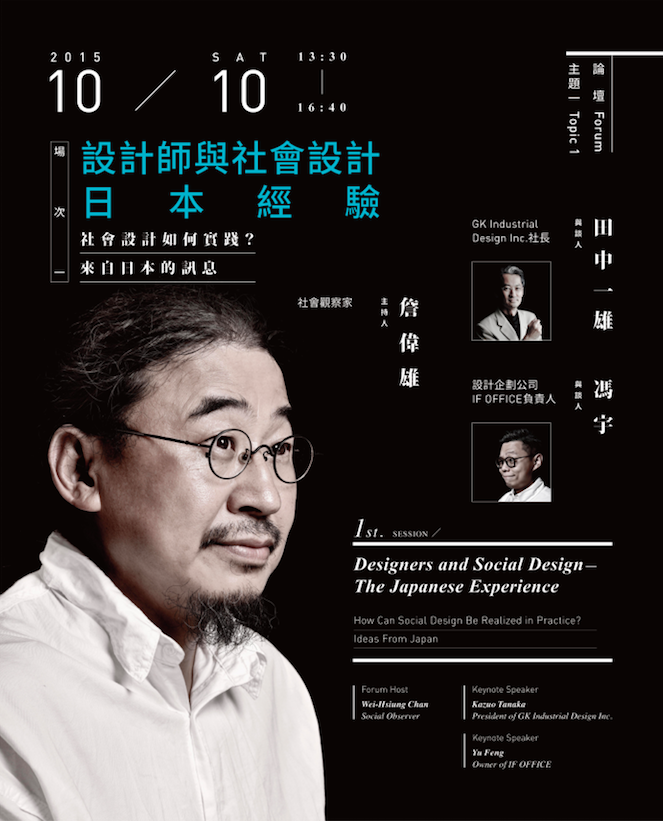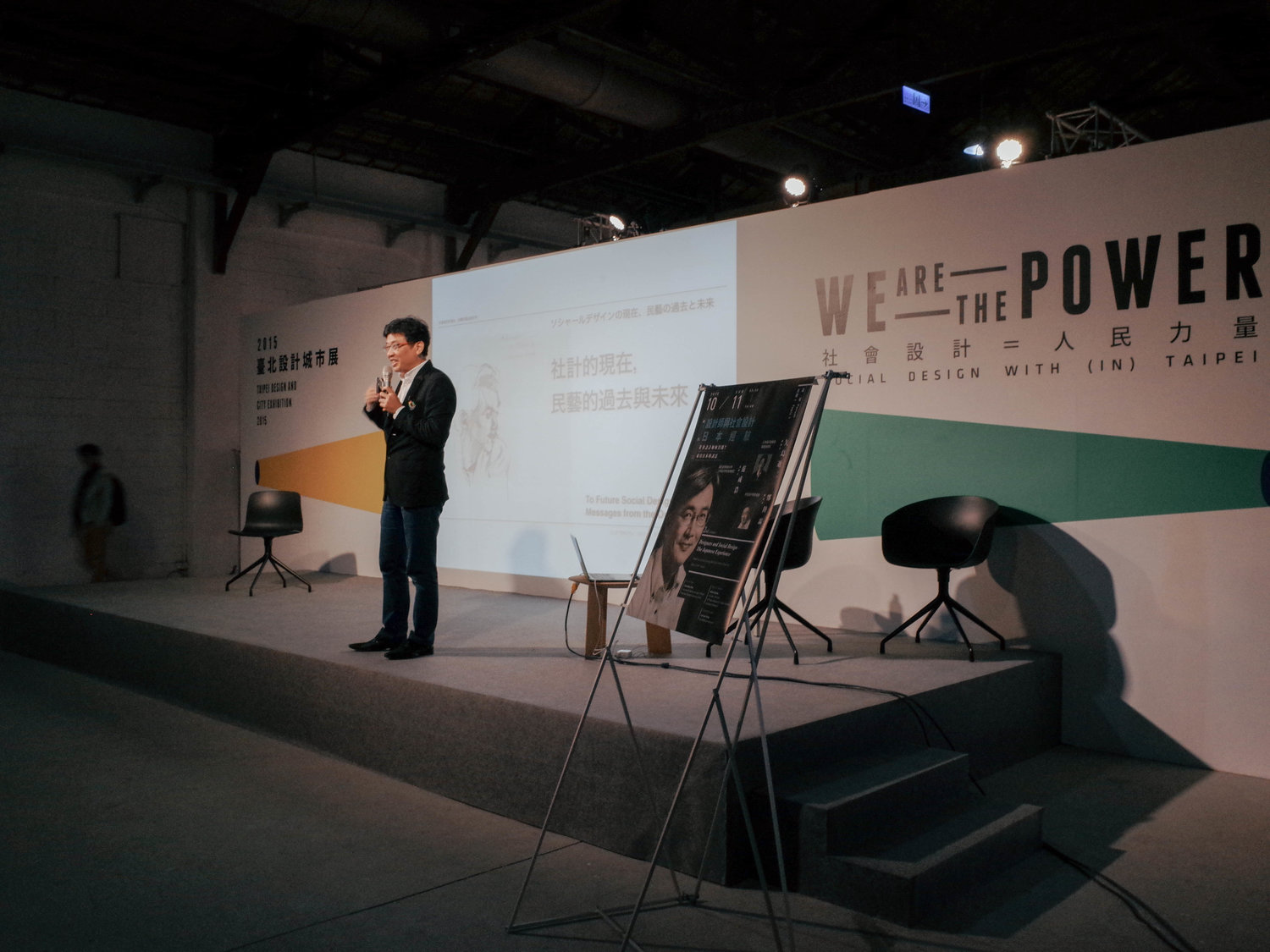社會設計如何實踐?來自日本的訊息
How Can Social Design Be Realized in Practice? Ideas From Japan
日本設計力的社會基礎來自於設計師對於生活的洞察力,本場論壇邀請日本設計家與國內學者談論從視覺設計、工業設計到環境規劃的社會定位與實踐。
Designers’ detailed observations of the ordinary lifestyle provide the social foundation for Japan’s renewed design prowess. From graphic and industrial designs to residential housing styles, the ideas behind mundane routines are prime subjects for aspiring social designers. At this forum, a veteran Japanese designer will talk about designers’ social position and how knowledge is put into practice.
設計師與社會設計 - 日本經驗
文|范成浩 [ 國立臺灣藝術大學 工藝設計學系助理教授 ]
人類近代史上,有幾個重要的活動:一個是法國大革命,一個是工業革命。這些活動的共同點就是要破除階級,帶領人類在政治、社會及產業等領域,走向現代化。在近代設計史上,曾經發生在英國的美術工藝運動(Arts and Crafts Movement),不僅強調美要回歸到人的生活,也希望能打破勞役不均的現象,運用設計的想法,試圖改變人類的生活方式,可以說是社會設計的先驅。
在亞洲的日本,柳宗悅先生在當時日本工藝的兩大主軸(工:殖產興業,走的是帝國工藝路線;藝:文明開化,走的是日本工藝美術路線)之外,提倡了”民藝”, 造就了日本的”工藝精神”,逐漸在日本民間開花結果,並由其兒子柳宗理先生實踐了這樣的思想,凡事精益求精,擁有品質高超的製造能力。
二次大戰之後,日本挾著其精湛的製造工藝,再次結合設計,締造日本成為經濟大國。然而,在過度強調其商業之間的競爭、技術不斷提升發展,對於物品之於人的存在意義,卻逐漸地迷失。1995年的阪神大地震以及2011年日本東北大地震,再次喚起設計界重新思考設計對消費者、產業以及對社會的意義,強調設計必須從看得見的美,進化到看不見的美,不僅物品的製造,互動、服務、地區發展都需要透過設計的力量來改變,從這幾年優良設計獎的得獎內容,可以明顯看出設計師正在透過設計來改變社會。
社會設計,不只是單純的設計一件物品,而是重新透過一些流程的設計,讓全民能夠參與社會的議題,並透過全民的力量,改變社會向上。
Designers and Social Design: The Japanese Experience
Text by Chen-Hao Fan [ Assistant Professor of Craft & Design, National Taiwan University of Arts ]
Two important movements in recent human history: The French Revolution and the Industrial Revolution. The similarity they share is breaking social class and leading people to modernize in politics, social progress, and industries. In recent history of design, there was the Arts and Crafts Movement across the British Empire, advocating not just the reconnection of beauty and life, but also economic and social reform with design ideas to change the way people live. The movement is a social design pioneer.
In Asia, Japan, Soetsu Yanagi advocated the mingei (folk craft) movement against the backdrop of the two mainstreams of Japanese arts: the imperial industrial art and the Japanese culture-based industrial art. The mingei movement bloomed and his spirit was later realized by his son Sori Yanagi. The idea gave birth to Japan’s Craftsmanship: pursuing perfection. Thanks to that, Japan boasts high quality manufacturing power.
After WWII, Japan combined its Craftsmanship with design and rose as an influential economy, however, was lost during endless commercial competition. The Great Hanshin earthquake in 1995 and the Tohoku earthquake in 2011 awakened the Japanese design community to rethink the meaning of design to the consumers, the industries, and the society, and emphasize that design must progress from visible beauty to invisible one. Everything, including manufacturing, interactions, services, and regional developments, needs to change with the power of design. From the winning works of the Good Design Award, one can clearly see that designers are changing the society through design.
Social design is not simply designing an object. It is designing procedures to allow the public to participate in social issues, and with the power of the people, to change the society.
▎場次一
Oct|10|2017|13:30 - 16:40
▧ 主持人|詹偉雄【社會觀察家】
▧ 與談人|田中一雄【GK Industrial Design Inc. 社長】、馮宇【設計企畫公司 IF OFFICE 負責人】
▧ Forum Host|Wei-Hsiung Chan [ Social Observer ]
▧ Keynote Speaker|Kazuo Tanaka [ President of GK Industrial Design Inc. ], Yu Feng [ Owner of IF OFFICE ]
▎場次二
Oct|11|2017|13:30 - 16:40
▧ 主持人|范成浩【國立臺灣藝術大學 工藝設計學系助理教授 】
▧ 與談人|矢島進二【日本設計振興會事業部 部長】、鄭陸霖【社會設計策略專家】
▧ Forum Host|Chen-Hao Fan [ Assistant Professor of Craft & Design, National Taiwan University of Arts ]
▧ Keynote Speaker|Shinji Yajima [ Executive Director of Project Department, Japan Institute of Design Promotion ], Lu-Lin Cheng [ Social Design Strategist ]









